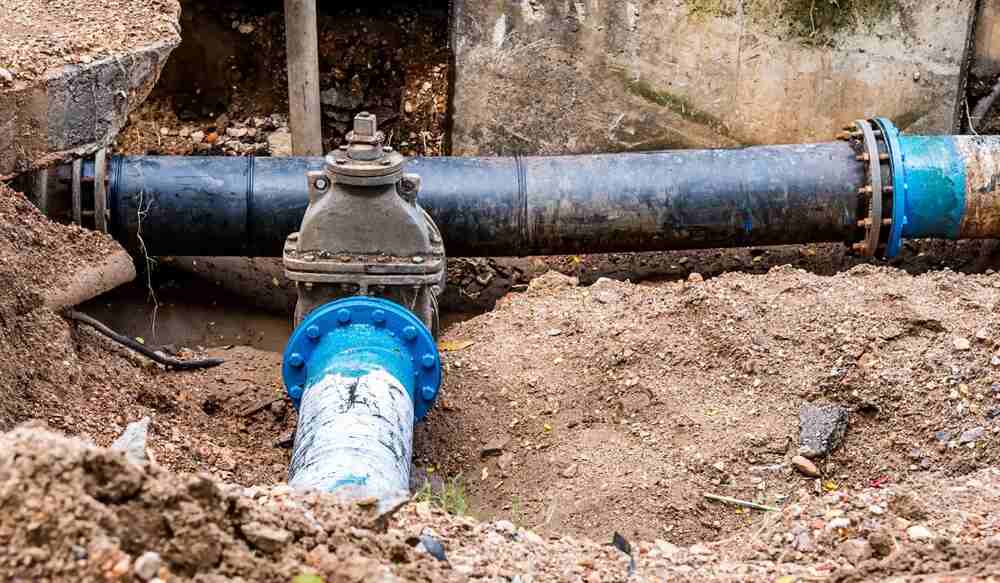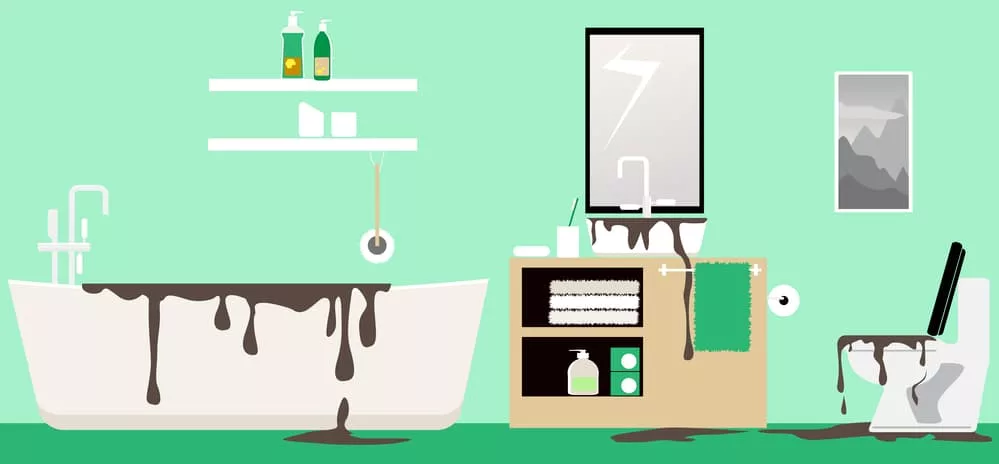Some things in our homes are meant to be kept well apart. Take your toilet and shower for instance. Having a backed-up toilet is bad, but when the toilet clog seeps into your shower, it can turn into a horrific nightmare. Now you’re probably aware that your toilet and shower system are connected and when there’s an issue with one of them, it usually affects the other.
Why Your Toilet is Overflowing into Your Shower
A working toilet system drains through your sewer line, carrying wastewater into the main sewer. However, if the wastewater drains into your shower, it means there’s an obstruction in your toilet system. Imagine your sewer system as a river with smaller streams of water. These smaller streams are your secondary drains and they make up the main drain line. If the river which is your main drain gets even partially blocked, it will cause obstructions in the smaller sewers like your bathroom and toilet systems.
Causes of Clogged Toilets
A lot of things can create blockages in your toilet line but here are some of the most common toilet blockers:
Tree roots
Trees love water as much as we do and your sewer line is an abundant water source especially if you have leaks. In the dry season, tree roots usually dig deeper into the ground searching for water. Your neighbor’s tree may just find its thirst quenched by your sewer line. However, the roots may break off which can cause an obstruction in the sewer line.
Foreign objects
Things like female hygiene items, toilet paper, your kid’s toys, paper towels, and even the so-called flushable wipes can cause obstructions in your sewer.
Water, biodegradable toilet paper, and human waste products are the only things that should be going into your toilet drain. Any other item will create clogs and may even lead to sewer damage.
Hair
Although it doesn’t occur rapidly, we do lose some strands of hair when we bathe. Don’t panic as it’s just a very little amount. However, it can be a huge problem for your drain when it accumulates. Hair plugs occur when strands of fallen hair form a net and trap other substances that would usually flow into the drain. As this plug accumulates in your sewer, it can reduce the flow of your drain and even block it completely.
Pipe scale
Scale is the calcium or magnesium composite that is found in our water. It usually forms on moist surfaces and can build up in your sewer lines, causing clogs.
Grease
One of the nastiest causes of clogged drains is grease and oils. When you wash your dirty dishes, the grease and fats can enter through your kitchen drain to the toilet and shower drain. If the grease residues build up and block the main drain, it may affect your toilet drain.

Discover the Game Changing Benefits of Trenchless Pipe Repairs with NW Sewer and Drain
Other miscellaneous materials
Apart from these materials listed above, other things can block your drains such as soap buildup and laundry detergent. These and other materials can block your toilet and shower drains.
How To Unclog Your Toilet Drains
Here are some effective methods you can use to unclog your drain:
Use a Plunger
You can start with a plunger to remove whatever might be causing the clogs. It’s best to use a toilet plunger that has a rubber flange, specially made for toilets. This will ensure that you get a good seal on the bottom of the toilet bowl.
Use steady, rhythmic movements with the plunger. Ensure you check the toilet bowl for any material that shows that the blockage is dissolving.
Try a Plumber’s Snake
If plunging doesn’t work, try using a plumber’s snake. It’s a long wire or cable that has a corkscrew at one end. The plumber uses the handle to turn the corkscrew, removing the clogs and clearing the drain. Push the snake into the toilet as far as you can and check for blockages. Afterward, turn in the shower and see if the clogs have been cleared.
Remove the Toilet
This method allows you to have a better look at the drain and locate any potential blockages. Removing your toilet will also help you to insert your plumber’s snake farther into the sewer.
Many toilets are fitted with a pair of bolts on each side of the bowl, and the water feed lines. The pipeline is closed with a wax seal, which you will have to replace before re-installing your toilet. Push the snake as far into the drain as you can, and turn on the shower to see if there is a free flow.
Drain Clean Out
Nowadays, modern homes have a sewer line clean-out plug placed somewhere in their drain line. The plug looks like a large screw-in cap and can be found on the end of the drain in your basement, or outside your home.
You can remove the plug to access your drain line. Afterward, feed a snake into the drain and unclog it. Make sure all the blockages have been cleared. However, if the blockage is deeper, you may need the assistance of a professional drain cleaning service to look at the sewer line.
If all the methods above fail, you have to seek the help of a professional drain cleaning service. Sometimes the cause of the blockage may be a small clog in the pipe from your house to the main drain. However, the distance may be too long for a simple snake. The clog might be stronger and need more force.
It could also be that some tree roots have dug into the drain from your house to the main line or your entire sewer line has collapsed. Either way, you will need the help of an expert drain cleaning service.
Speak With Your Local Sewer Repair in Seattle
We are dedicated to serving all of our customers’ sewer-related requirements here at NW Sewer & Drain. You can reach out to us today at office@nwsewer.com.
We’re excited to help you sort out any drain issues you might be facing in your home or office building. Ideally, consulting an experienced local sewer and drain cleaning company should be your following line of action if you are experiencing slow-moving drains, foul odor, or clogged drains in your home and need help figuring out what else to do.
At N.W. Sewer & Drain, we have a well-trained and ready-to-move team on standby. We serve the Seattle metropolitan area, including Bellevue, Kirkland, Shoreline, Renton, Lake Forest Park, Mountlake Terrace, Auburn, Everett, Marysville, Mount Vernon, and other surrounding areas.
N.W. Sewer & Drain provides top-notch drain cleaning and sewer repair services in the greater Seattle area, and we’ve been in the business for 20 years. Contact us today at 206-931-7728 to schedule an inspection of your sewer line and pipes.
FAQs About Toilet Overflowing into Shower
Why is my toilet overflowing into my shower?
When your toilet overflows into your shower, it’s typically due to an obstruction in your toilet’s drainage system. This obstruction causes the wastewater to flow back into the shower instead of through the sewer line, leading to the overflow.
What are the common causes of clogged toilets?
Common causes of clogged toilets include tree roots infiltrating the sewer line, foreign objects like feminine hygiene products and toys, hair buildup, pipe scale, grease and oil residue, soap buildup, and laundry detergent accumulation.
How can I unclog my toilet drains?
You can try using a plunger, plumber’s snake, or removing the toilet to access the drain. Additionally, utilizing the drain clean-out plug can help clear blockages. If DIY methods fail, it’s advisable to seek professional drain cleaning services.
What is a plumber’s snake, and how does it work?
A plumber’s snake is a long wire or cable with a corkscrew at one end. By inserting the snake into the toilet drain and turning the handle, it helps dislodge and remove clogs, restoring proper drainage.
Can tree roots cause toilet clogs?
Yes, tree roots seeking water sources can infiltrate sewer lines, causing obstructions and eventually leading to toilet clogs. Regular maintenance and inspections can help prevent root-related issues.
Why should I avoid flushing foreign objects down the toilet?
Flushing foreign objects like paper towels and hygiene products can lead to toilet clogs and sewer damage. Only water, biodegradable toilet paper, and human waste should be flushed to prevent obstructions.
What is pipe scale, and how does it contribute to clogs?
Pipe scale is the buildup of calcium or magnesium compounds found in water. When scale accumulates in sewer lines, it can restrict water flow and contribute to clogs, leading to toilet overflow issues.
How can I prevent toilet and shower drain clogs?
To prevent clogs, avoid flushing non-biodegradable items, use drain screens to catch hair and debris, and schedule regular maintenance to inspect and clean sewer lines.
When should I seek professional drain cleaning services?
If DIY methods fail to unclog the toilet or shower drain, or if there are signs of a more significant issue such as tree root infiltration or sewer line damage, it’s time to contact a professional drain cleaning service.

N.W. Sewer & Drain offers top-notch drain cleaning and sewer repair services in the Seattle area, with a well-trained team and nearly 20 years of experience. Contact us today for reliable solutions to your drain issues.


